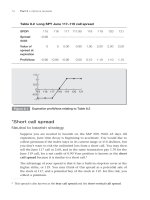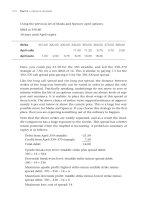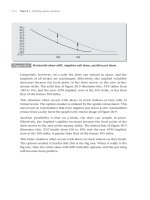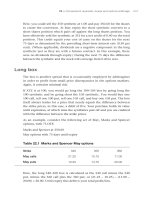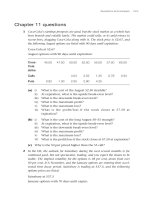CWNA guide to wireless LANs 2nd ch06
Bạn đang xem bản rút gọn của tài liệu. Xem và tải ngay bản đầy đủ của tài liệu tại đây (451.1 KB, 40 trang )
CWNA Guide to Wireless
LANs, Second Edition
Chapter Six
Planning and Deploying a Wireless LAN
Objectives
•
•
•
•
Explain the steps for planning a wireless network
Tell how to design a wireless LAN
Describe the steps in deploying a wireless network
Explain the ways in which to provide user support
CWNA Guide to Wireless LANs, Second Edit
2
Planning for a Wireless Network
• “If you fail to plan, then you plan to fail”
• Some steps involved in planning wireless networks
similar to planning wired network
– Many steps significantly different
• Basic planning steps:
– Assessing needs
– Weighing benefits
– Calculating costs
CWNA Guide to Wireless LANs, Second Edit
3
Assessing Needs: The Need for
Mobility
• Two significant changes in business world over last
15 years:
– Workers have electronic tools to access information
and accomplish significantly more
– Restructuring of organizational hierarchies
• Organizations are “flatter”
• Teamwork is essential
– Together, can result in decreased productivity
• Hinders ability to collaborate and make timely
decisions
• “Mobile office” needed
CWNA Guide to Wireless LANs, Second Edit
4
Assessing Needs: The Need for
Mobility (continued)
• A solution to need for mobility is WLANs
– Expand productivity zone of knowledge workers
– Improve quality and productivity of meetings
– Work can be performed in more locations at more
times
• WLANs have been shown to add one to two hours
a day of productive time per worker
– Enabling worker to respond to customers, partners,
and colleagues more quickly
• WLANs too often viewed as optional add-on to
computer networks
CWNA Guide to Wireless LANs, Second Edit
5
Assessing Needs: Examining the
Business Entity
• Determine if business case exists for bringing
wireless networking into corporate environment
– What is the purpose or mission of the organization?
– Is the current mission expected to change in the
future?
– What is the size of the organization?
– How much growth is anticipated in the organization?
• Obtaining firm conceptual grip on organization as a
whole and its current status will reveal if an
investment in wireless technology is wise
CWNA Guide to Wireless LANs, Second Edit
6
Assessing Needs: Reviewing the
Current Network
• Question to ask when examining how organization
uses current network:
– How does current network support the organization’s
mission?
– What applications run on the network?
– How many users does network support?
– Strengths and weaknesses of the current network?
– Anticipated growth in network technology?
• Examining current network status reveals much of
this information
– Especially applications and number of users
CWNA Guide to Wireless LANs, Second Edit
7
Assessing Needs: Reviewing the
Current Network (continued)
• Good time to document network in detail:
–
–
–
–
–
–
–
Number of clients
Types of clients
Number of servers
The topology of the network
What media is being used
Performance of the network
Types of devices connected to the network
CWNA Guide to Wireless LANs, Second Edit
8
Assessing Needs: Reviewing the
Current Network (continued)
Table 6-1: Current network table
CWNA Guide to Wireless LANs, Second Edit
9
Assessing Needs: Reviewing the
Current Network (continued)
Figure 6-1: Network diagram
CWNA Guide to Wireless LANs, Second Edit
10
Determining Benefits: Hard Benefits
• Benefits that can be easily measured or quantified
– For WLANs, easily measured in decreased cost of
installation
• e.g., elimination of cabling costs
• Using wireless technology for MAN or WAN can
result in even higher savings
CWNA Guide to Wireless LANs, Second Edit
11
Determining Benefits: Soft Benefits
• Benefits that are difficult, if not impossible, to
quantify accurately
–
–
–
–
–
Improved productivity
Enhanced collaboration and faster responsiveness
Flexible mobility
Adherence to standards
Improved employee satisfaction
CWNA Guide to Wireless LANs, Second Edit
12
Calculating Return on Investment
(ROI)
• Return on investment (ROI): Standard measure
of profitability of a project
– Total cost of project
• Hardware, software, implementation costs, training,
operations staff, maintenance staff and services, and
connectivity fees
– Less tangible costs
• Workload management and customer satisfaction
• Several models for calculating ROI
CWNA Guide to Wireless LANs, Second Edit
13
Calculating Return on Investment
(continued)
• Intel Corporation’s wireless LAN model:
–
–
–
–
Implement a pilot
Develop a report
Assemble data
Calculate ROI
Table 6-2: Three-year WLAN costs and benefits
CWNA Guide to Wireless LANs, Second Edit
14
Calculating Return on Investment
(continued)
Figure 6-2: Intel’s ROI model for WLANs
CWNA Guide to Wireless LANs, Second Edit
15
Designing the Wireless LAN
• Involves determining:
– Which deployment scenario is best
– Which IEEE wireless network standard should be
used
– Type of AP management to implemented
– Where wireless devices should be located
CWNA Guide to Wireless LANs, Second Edit
16
Determining the Deployment Scenario
• First step in designing a WLAN is to decide on
correct deployment scenario:
– Ad hoc: Not connected to wired infrastructure
• Useful where wireless infrastructure does not exist or
services to remote networks not required
– Infrastructure: WLAN devices connect to wired
corporate network via AP
• Most corporate wireless LANs
– Hotspot: Provides wireless LAN service, for free or
for a fee, from variety of public areas
– Point-to-point remote wireless bridge: Typically
interconnects two LAN segments
CWNA Guide to Wireless LANs, Second Edit
17
Determining the Deployment Scenario
(continued)
• Deployment scenarios (continued):
– Point-to-multipoint remote wireless bridge: Connects
multiple LAN segments
– Ethernet to wireless bridge: Connects single device
that has an Ethernet port but not an 802.11 NIC
– Wireless gateway: Provide single mechanism for
managing and monitoring the wireless network
CWNA Guide to Wireless LANs, Second Edit
18
Selecting the IEEE Wireless Network
Type
• IEEE 802.11b, 802.11a, or 802.11g
• Decision may depend on many factors
– Do other devices in area use same frequency range
as one of the network types?
– What kind of coverage is needed?
– What types of applications will be used?
• If broader area of coverage needed, 802.11g
standard should be considered first
– Good balance of coverage area with speed
CWNA Guide to Wireless LANs, Second Edit
19
Selecting the IEEE Wireless Network
Type (continued)
• If interference is an issue, then 802.11a standard
should be considered
• Only consider 802.11b in areas where low
bandwidth is acceptable or ad hoc wireless network
will be used
– Slow speed and susceptibility to interference
CWNA Guide to Wireless LANs, Second Edit
20
Deciding upon Access Point
Management
• If using infrastructure wireless network, must
decide type of AP management
• Fat access point: AP serves as management point
– Configuration must be done through via AP
• Thin access point: Lacks management functions
– Management functions moved to Ethernet network
switch
– Management simplified, centralized
– Handoff time reduced
– Thin access points are proprietary
CWNA Guide to Wireless LANs, Second Edit
21
Deciding upon Access Point
Management (continued)
• Thin AP approach does not provide overall solution
for managing entire network (wired and wireless)
• Several vendors working on comprehensive
network management solutions
– Integrate wireless networks into same deployment,
operations, and management as wired network
– e.g., Cisco’s Structured Wireless-Aware Network
(SWAN)
CWNA Guide to Wireless LANs, Second Edit
22
Determining the Location of the
Wireless Devices
Table 6-3: Interference by objects
CWNA Guide to Wireless LANs, Second Edit
23
Ad Hoc Mode
• Wireless devices communicate directly without an
AP
• Three main considerations:
– Stations must be arranged so that they are all within
proper distance limits
– All stations must send and receive signals on same
frequency
– Hidden node problem must be avoided
CWNA Guide to Wireless LANs, Second Edit
24
Ad Hoc Mode (continued)
Figure 6-3: Ad hoc hidden node problem
CWNA Guide to Wireless LANs, Second Edit
25




